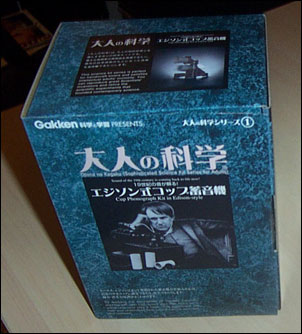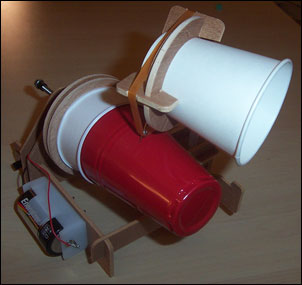I have a short review of Gakken’s Berliner Gramophone and Edison Cylinder kits in the ‘Toolbox’ section of the second issue of Make Magazine. If you aren’t familiar with Make Magazine, it’s basically a comprehensive quarterly manual of nerdery. This issue also includes articles on writing your own Atari 2600 software, building a robot from an old mouse, and running linux on ipods if that helps frame things for you. You can pick up a copy on Amazon, or at your local newsstand (I made a point of visiting the Barnes & Noble where I once worked to purchase it).

The review is mercifully brief (it had to be under 300 words), but the basic jist of it was that I thought the Gramophine kit was more bang for the buck, all things considered. I had a relatively problem-free experience with the gramophone kit, while I ran into all sorts of recording difficulty with the cylinder kit. To be fair, I’ve since heard from two gents who had the same sort of problems with the Gramophone kit that I experienced with the cylinder kit, so I suppose that means all bets are off. Those interested in further details on the Gramophone kit can find my previous posting here.
The Edison Cylinder kit was actually the first Kit in Gakken’s adult education series, so I surmised that the inferiority of this exercise when compared with my Gramophone kit experience can be chalked up to the various manufacturing refinements that Gakken made as the series progressed. The Cylinder kit is also much less a ‘showpiece,’ constructed from “Make a dinosaur skeleton!”-style bits of wood.

I’ve only managed to make one successful recording with the Cylinder kit, though that’s primarily because I ran out of “cylinders” at about the same time that I started to get good at aligning everything. You’d be surprised at how hard it is to find plastic cups without ridges, etc. already molded into the sides. Anyway – I’ve included a 30 second clip of the “successful” run, which should give you a rough idea of the difficulties I experienced with this particular kit. I have no idea what I was singing (This was recorded sometime in January), but it comes out sounding like a distant, drunk wookie. The clip also effectively illustrates how loud the motor is – it’s hard to hear the drunk wookie over it. This is the primary reason I’d recommend the Gramophone kit over the Cylinder kit – you’ll at least have a shot at hearing your recording.

Gakken Edison Cylinder Model – “???”
From: My Diningroom Table
Hobby Life Japan, the company that imported these kits for me at the end of 2004, has since vanished from the web. Thankfully, both kits are still available to inquisitive Americans via Verycoolthings.com (Gramophone kit, Edison Cylinder kit). Back in March, Peter Giles, one of the dudes behind the site emailed me, offering anyone who mentions kempa.com in the comments of their order for a Gakken Kit the following deal:
“We would like to make this offer to your readers living in the US: if they mention your site in their comments when they order this kit, we will refund their shipping, keeping their total at $59.99, and we will upgrade their shipping to USPS Priority (2-3 day delivery).”
I just checked with Peter and they’re still willing to honor this deal, so if you’ve been waiting for an excuse to order nerdy model kits, go nuts.